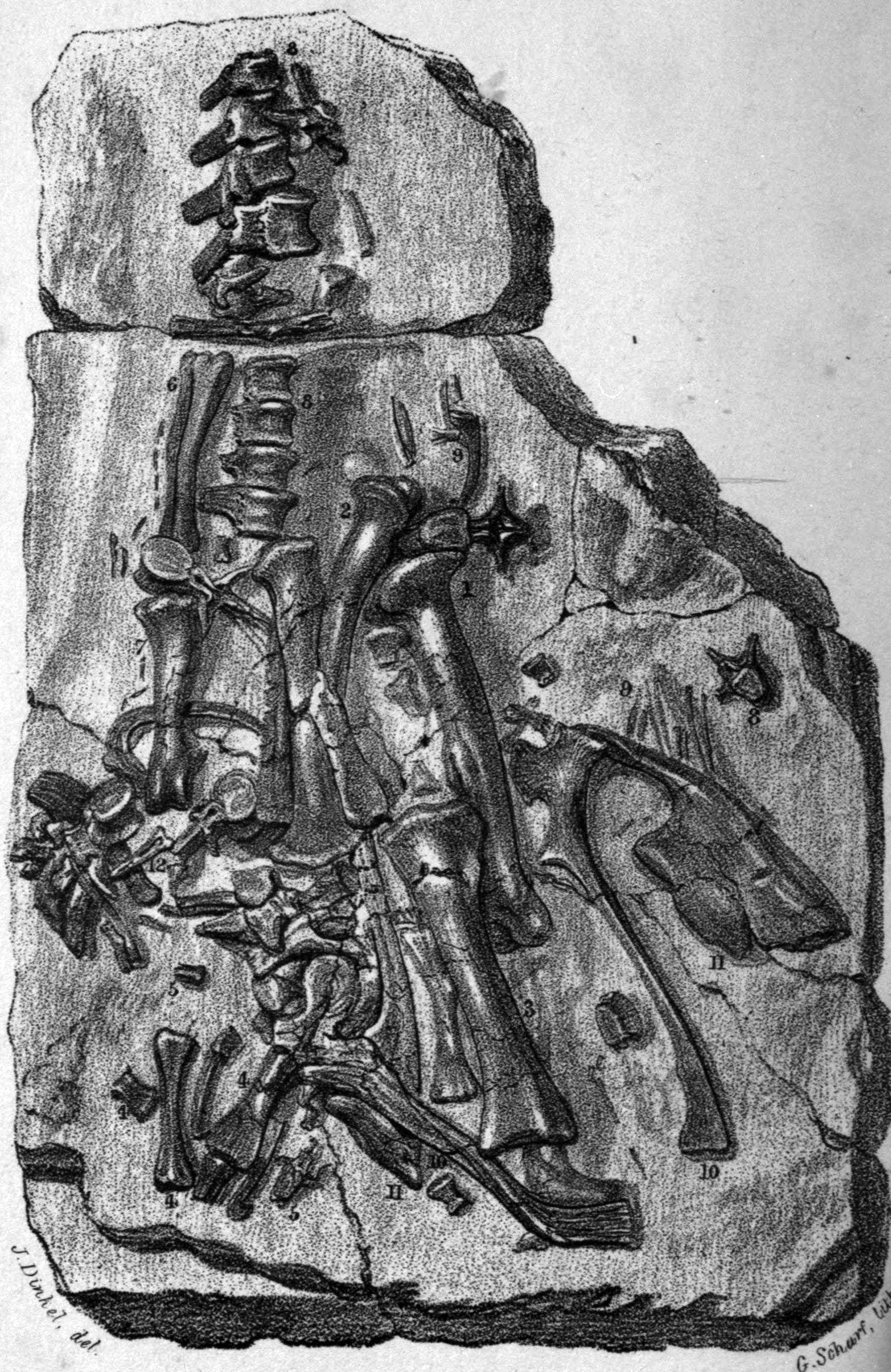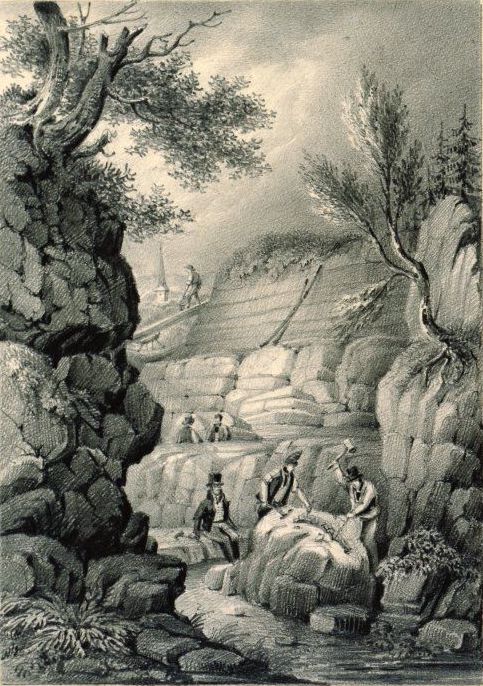|
Iguanodon
''Iguanodon'' ( ; meaning 'iguana-tooth'), named in 1825, is a genus of iguanodontian dinosaur. While many species found worldwide have been classified in the genus ''Iguanodon'', dating from the Late Jurassic to Early Cretaceous, Taxonomy (biology), taxonomic revision in the early 21st century has defined ''Iguanodon'' to be based on one well-substantiated species: ''I. bernissartensis'', which lived during the Barremian to early Aptian ages of the Early Cretaceous in Belgium, Germany, England, and Spain, between about 126 and 122 million years ago. ''Iguanodon'' was a large, bulky herbivory, herbivore, measuring up to in length and in body mass. Distinctive features include large thumb spikes, which were possibly used for defense against predation, predators, combined with long prehensile fifth fingers able to forage for food. The genus was named in 1825 by English geologist Gideon Mantell, based on fossil specimens found in England and was given the species name ''I. ... [...More Info...] [...Related Items...] OR: [Wikipedia] [Google] [Baidu] |
Mantellisaurus
''Mantellisaurus'' is a genus of iguanodontian dinosaur that lived in the Barremian and early Aptian ages of the Early Cretaceous Period of Europe. Its remains are known from Belgium (Bernissart), England, Spain and Germany. The type species, type and only species is ''M. atherfieldensis''. Formerly known as ''Iguanodon atherfieldensis'', the new genus ''Mantellisaurus'' was erected for the species by Gregory Paul in 2007. According to Paul, ''Mantellisaurus'' was more lightly built than ''Iguanodon'' and more closely related to ''Ouranosaurus'', making ''Iguanodon'' in its traditional sense paraphyletic. It is known from many complete and almost complete skeletons. The genus name honours Gideon Mantell, the discoverer of ''Iguanodon''. History of discovery Discovery and naming of the holotype The holotype fossil, NHMUK PV R5764, was originally discovered by Reginald Walter Hooley in 1914 in the upper Vectis Formation of southern England and reported upon in 1917. He posthumou ... [...More Info...] [...Related Items...] OR: [Wikipedia] [Google] [Baidu] |
Iguanodontia
Ornithopoda () is a clade of ornithischian dinosaurs, called ornithopods (). They represent one of the most successful groups of herbivorous dinosaurs during the Cretaceous. The most primitive members of the group were bipedal and relatively small-sized, while advanced members of the subgroup Iguanodontia became quadrupedal and developed large body size. Their major evolutionary advantage was the progressive development of a chewing apparatus that became the most sophisticated ever developed by a non-avian dinosaur, rivaling that of modern mammals such as the domestic cow. They reached their apex of diversity and ecological dominance in the hadrosaurids (colloquially known as 'duck-bills'), before they were wiped out by the Cretaceous–Paleogene extinction event along with all other non- avian dinosaurs. Members are known worldwide. History of research In 1870, Thomas Henry Huxley listed Iguanodontidae (coined by Edward Drinker Cope a year earlier) as one of his three famil ... [...More Info...] [...Related Items...] OR: [Wikipedia] [Google] [Baidu] |
Hypselospinus
''Hypselospinus'' is a genus of iguanodontian dinosaur which was first described as a species of ''Iguanodon'' (''I. fittoni'') by Richard Lydekker in 1889, the specific name (zoology), specific name honouring William Henry Fitton. History and naming In the 1880s, the Natural History Museum, London, purchased multiple collections of fossils discovered by Charles Dawson from the region Hastings. Among these collections of specimens were multiple individuals identified as species of ''Iguanodon'' by British palaeontologist Richard Lydekker, from the Early Cretaceous Wadhurst Clay Formation. The first of these specimens, NHMUK R.1635, was found in Shornden Quarry over distance of , and includes a partial and believed to be from a single individual. As the specimen was smaller than and younger than the similar and nearby species ''Iguanodon dawsoni'' and the pelvis showed some differences, Lydekker chose to name the new species ''Iguanodon fittoni'' in 1889 in paleontology, 1889, wi ... [...More Info...] [...Related Items...] OR: [Wikipedia] [Google] [Baidu] |
Dinosaur
Dinosaurs are a diverse group of reptiles of the clade Dinosauria. They first appeared during the Triassic Geological period, period, between 243 and 233.23 million years ago (mya), although the exact origin and timing of the #Evolutionary history, evolution of dinosaurs is a subject of active research. They became the dominant terrestrial vertebrates after the Triassic–Jurassic extinction event 201.3 mya and their dominance continued throughout the Jurassic and Cretaceous periods. The fossil record shows that birds are feathered dinosaurs, Evolution of birds, having evolved from earlier Theropoda, theropods during the Late Jurassic epoch, and are the only dinosaur lineage known to have survived the Cretaceous–Paleogene extinction event approximately 66 mya. Dinosaurs can therefore be divided into avian dinosaurs—birds—and the extinct non-avian dinosaurs, which are all dinosaurs other than birds. Dinosaurs are varied from taxonomy (biology), taxonomic, ... [...More Info...] [...Related Items...] OR: [Wikipedia] [Google] [Baidu] |
Royal Belgian Institute Of Natural Sciences
The Museum of Natural Sciences (, ; , ) is a Brussels museum dedicated to natural history. It is a part of the Royal Belgian Institute of Natural Sciences (; ), itself part of the institutions of the Belgian Federal Science Policy Office (BELSPO). The Dinosaur Hall of the museum is the world's largest museum hall completely dedicated to dinosaurs. Its most important pieces are 30 fossilised ''Iguanodon'' skeletons, which were discovered in 1878 in Bernissart, Belgium. Another famous piece is the Ishango bone, which was discovered in 1960 by Jean de Heinzelin de Braucourt in the Belgian Congo. The museum also houses a research department and a public exhibit department. The museum is located at 29, /, in Leopold Park, close to the Brussels and the European Union#European Quarter, European institutions and the House of European History (HEH). This area is served by Brussels-Luxembourg railway station, as well as by the Brussels Metro, metro stations Maalbeek/Maelbeek metro statio ... [...More Info...] [...Related Items...] OR: [Wikipedia] [Google] [Baidu] |
Gideon Mantell
Gideon Algernon Mantell Membership of the Royal College of Surgeons, MRCS Fellow of the Royal Society, FRS (3 February 1790 – 10 November 1852) was an English obstetrician, geologist and paleontology, palaeontologist. His attempts to reconstruct the structure and life of ''Iguanodon'' began the scientific study of dinosaurs: in 1822 he was responsible for the discovery (and the eventual identification) of the first fossil teeth, and later much of the skeleton, of ''Iguanodon''. Mantell's work on the Cretaceous of southern England was also important. Early life and medical career Mantell was born in Lewes, Sussex as the fifth-born child of Thomas Mantell, a shoemaker, and Sarah Austen. He was raised in a small cottage in St. Mary's Lane with his two sisters and four brothers. As a youth, he showed a particular interest in the field of geology. He explored pits and quarries in the surrounding areas, discovering ammonites, shells of sea urchins, fish bones, coral, and worn-out ... [...More Info...] [...Related Items...] OR: [Wikipedia] [Google] [Baidu] |
Megalosaurus
''Megalosaurus'' (meaning "great lizard", from Ancient Greek, Greek , ', meaning 'big', 'tall' or 'great' and , ', meaning 'lizard') is an extinct genus of large carnivorous theropod dinosaurs of the Middle Jurassic Epoch (Bathonian stage, 166 million years ago) of southern England. Although fossils from other areas have been assigned to the genus, the only certain remains of ''Megalosaurus'' come from Oxfordshire and date to the late Middle Jurassic. The earliest remains of ''Megalosaurus'' were described in the 17th century, and were initially interpreted as the remains of elephants or giants. ''Megalosaurus'' was named in 1824 by William Buckland, becoming the first genus of (non-avian) dinosaur to be validly named. The type species is ''M. bucklandii'', named in 1827 by Gideon Mantell, after Buckland. In 1842, ''Megalosaurus'' was one of three genera on which Richard Owen based his Dinosauria, along with ''Iguanodon'' and ''Hylaeosaurus''. On Owen's directions a model was ma ... [...More Info...] [...Related Items...] OR: [Wikipedia] [Google] [Baidu] |
Louis Dollo
Louis Antoine Marie Joseph Dollo (; 7 December 1857 – 19 April 1931) was a Belgian palaeontologist, known for his work on dinosaurs. He also posited that evolution is not reversible, known as Dollo's law. Together with the Austrian Othenio Abel, Dollo established the principles of paleobiology. Early life Louis Dollo was born in Lille, Nord-Pas-de-Calais, a scion of an old Breton family. He studied at the École centrale de Lille, with geologist Jules Gosselet and zoologist Alfred Giard, both of whom influenced the young Dollo. In 1877, he graduated with a degree in engineering. After his graduation, he worked in the mining industry for five years, but simultaneously developed a passion for paleontology. In 1879, he moved to Brussels. ''Iguanodon'' spp. For three years, starting in 1878, he supervised the excavation of the famous, multiple ''Iguanodon'' find at Bernissart, Belgium. He devoted himself to their study as a scientific passion, initially concurrently with hi ... [...More Info...] [...Related Items...] OR: [Wikipedia] [Google] [Baidu] |
Barilium
''Barilium'' is a genus of iguanodontian dinosaur which was first described as a species of ''Iguanodon'' (''I. dawsoni'') by Richard Lydekker in 1888, the specific epithet honouring the discoverer Charles Dawson, who collected the holotype during the 1880s. In 2010 it was reclassified as a separate genus by David Norman. The generic name ''Barilium'' is derived from Greek ''barys'', "heavy", and Latin '' ilium''. Later in 2010, Kenneth Carpenter and Yusuke Ishida independently assigned it to the new genus ''Torilion'',Carpenter, K. and Ishida, Y. (2010).Early and “Middle” Cretaceous Iguanodonts in Time and Space. ''Journal of Iberian Geology'', 36 (2): 145-164. which is thus a junior objective synonym of ''Barilium''. It is known from two partial skeletons found near St Leonards-on-Sea in East Sussex, England, from the middle Valanginian-age Lower Cretaceous Wadhurst Clay. Lydekker based the species on the syntype series BMNH R798, 798a, 803-805, 806, 798b, 802, 802a and ... [...More Info...] [...Related Items...] OR: [Wikipedia] [Google] [Baidu] |
Hylaeosaurus
''Hylaeosaurus'' ( ; Greek: / "belonging to the forest" and / "lizard") is a herbivorous ankylosaurian dinosaur that lived about 136 million years ago, in the late Valanginian stage of the early Cretaceous period of England. It was found in the Grinstead Clay. ''Hylaeosaurus'' was one of the first dinosaurs to be discovered, in 1832 by Gideon Mantell. In 1842 it was one of the three dinosaurs Richard Owen based the Dinosauria on, the others being ''Iguanodon'' and ''Megalosaurus''. Four species were named in the genus, but only the type species ''Hylaeosaurus armatus'' is today considered valid. Only limited remains have been found of ''Hylaeosaurus'' and much of its anatomy is unknown. It might have been a basal nodosaurid, although a recent cladistic analysis recovers it as a basal ankylosaurid. ''Hylaeosaurus'' was about five metres long. It was an armoured dinosaur that carried at least three long spines on its shoulder. History of discovery The first ''Hylaeosauru ... [...More Info...] [...Related Items...] OR: [Wikipedia] [Google] [Baidu] |








